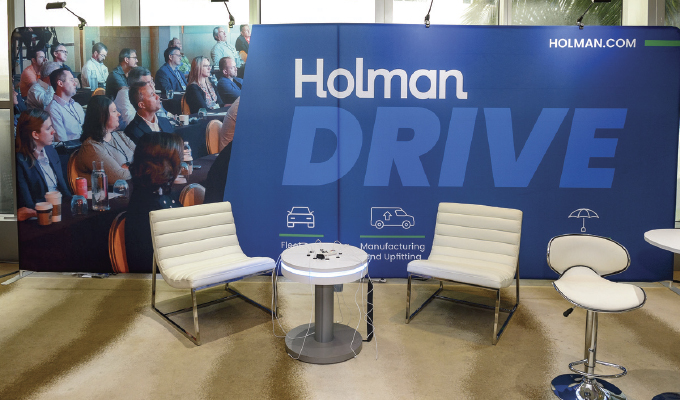November is a great time to visit Miami Beach, and it’s not a bad place to hold a conference, either. That’s just what Holman did this past fall. Holman, an integrated automotive services company, provides services and insight into fleet management, upfitting, vehicle equipment, vehicle sourcing, and so much more.
Holman described its event, Holman Drive, as “an opportunity to connect with leaders from across a variety of industries and participate in spirited, thought-provoking discussions.”
The event sessions consisted of discussion topics ranging from key trends impacting the automotive industry. Those trends included topics such as supply chain disruptions, the transition to EVs, pressures of inflation, and emerging technologies, among others. Read below for conference highlights: electric vehicle (EV) supply chain, post-pandemic outlook, and predicted takeaways for 2023.
EV SUPPLY CHAIN
In the Holman Drive session, New Realities, Holman President and Chief Operating Officer Chris Conroy discussed where the industry stands now and where it could be headed, taking a look at electric vehicles, specifically.
It’s no surprise the automotive and truck fleet industry is heavily focused on EVs. With societal and governmental pressure on fleets to lower their emissions and EVs making their way onto dealership lots, a fully electrified fleet is looking like less of a dream and more of a reality for some. Further, existing EV tax credits incentivize consumers to purchase EVs, and new EV tax credits work to incentivize OEMs to shift their EV supply chains to North America. Here’s why…
Globally, China is leading the way in terms of battery electric vehicle (BEV) sales. The country is home to 64% of global BEV sales. The country is also home to the mining and manufacture of many critical components required to power EVs.
The BEV supply chain can be broken down into five segments: 1) mining, 2) processing, 3) battery components, 4) batteries, and 5) vehicles. The United States heavily relies on China for those five components.
The US places a reliance on China of 80% for mining cobalt, where the US mines less than 1% of its own cobalt; it places a 60% reliance for lithium processing, where the US processes less than 1% of its own lithium. When it comes to battery components, the US relies on China for 80% of its anodes and 60% of its cathodes production, where the US produces less than 1% of either for its use. The United States places a 79% share of Li-ion battery manufacturing on China compared to its own 7%, and finally, only 10% of EVs are sold in the US compared to China’s 64%.

AFTER THE PANDEMIC
It’s no secret that the Covid-19 pandemic affected the supply chain, and with inflation on the rise, when will we begin to see some relief? Will operations ever resume to pre-pandemic levels?
Holman’s State of the Industry report states that multiple factors contributed to the inflation seen today. In the lockdowns of 2020, the GDP shrank by 30%, and unemployment rose to 14%. To keep the economy afloat, the federal government pumped money into the economy via stimulus. With extra liquidity in the system, Americans’ buying power increased causing demand for goods to skyrocket. Supply chains weren’t ready to handle this uptick in demand: think, the cargo ships that couldn’t dock at US ports and goods that were sitting in crates at shipyards for weeks.
The lockdowns that spawned remote work had many employees rethinking their work situation. Employees left businesses in droves to find more flexible work, which led companies to counter with higher wages. Wage growth has continued (although it’s currently moderating).
Now, today’s low unemployment numbers, businesses becoming healthy again, liquidity in the market, and a continuing demand for goods has led to a perfect recipe for increased prices. Some segments of inflation include energy, food, and shelter (people’s homes, apartments, housing, etc.).
It’s predicted that once wages level out, consumers will slow their spending, which will result in decreased demand, allowing the market to correct itself.

INFLATION & FLEETS
Just like the multiple factors that have played into inflation as a whole, multiple factors have also played into inflation of the automotive industry. One factor was the factory shutdowns during the pandemic, decreasing production and inventories. Another factor was a migration from the cities to the suburbs, increasing consumer demand for vehicles. Then, as demand grew, dealership inventories quickly depleted. Regardless, overall fleet sales are up.
Bringing the conversation full circle, the hottest segment of the vehicle marketplace rests on EVs. At the time of the report, global sales of EVs were projected to have a global growth of 57% year over year for 2022, exceeding 6% of global auto sales. Momentum is steady in the EV and BEV market, and with government incentives and tax credits combined with the research and development of both startups and legacy OEMs (General Motors and Ford), the needs of an EV consumer and fleet owner are being met on a regular basis.

TAKEAWAYS FOR 2023
Although we can share only a snapshot of recent events and provide mere predictions of the future, it’s best to keep a business plan for the future—no matter what it throws at your fleet business. Holman suggests keeping future fleet plans flexible for 2023 and involving all stakeholders in discussions and decisions to get a holistic picture of the business, budgets, and fleet needs.
FOR MORE INFORMATION
Find out more about Holman Drive and discover ways to increase your fleet’s efficiency, visit www.holman.com.




